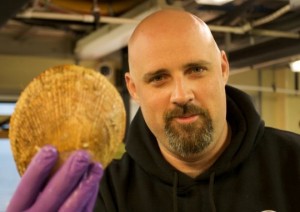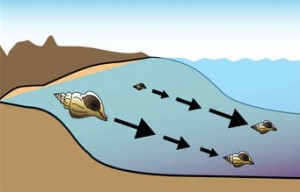Continued research emphasizes the universal importance of body size, its impact on significant ecological traits of an organism, and body size/niche relationships. Through my research, I strive to explain variation in size among organisms and over geographic gradients that will yield insight into those aspects of ecology and life history important to species.
 My recent work in Proceedings of the Royal Society and selected by the Faculty of 1000, demonstrates species diversity is correlated with size range across metazoan phyla and two vertebrate classes, implying a link between body size variation and niche diversity. This work also demonstrates that diversity in some phyla is limited by anatomical constraints that set lower and upper limits on body size.
My recent work in Proceedings of the Royal Society and selected by the Faculty of 1000, demonstrates species diversity is correlated with size range across metazoan phyla and two vertebrate classes, implying a link between body size variation and niche diversity. This work also demonstrates that diversity in some phyla is limited by anatomical constraints that set lower and upper limits on body size.- Prominent patterns of body size exist in the deep sea including conspicuous cases of both gigantism and dwarfism, illustrated by Giant Isopods reaching a third of a meter in length and miniature mussels measuring only a few millimeters in length. One of my primary research themes is the exploration of ecological and evolutionary processes that determine body size in deep-sea organisms. My early work focused on documenting patterns of body size variation with depth and found an overall decrease in body size across taxa but both positive and negative relationships within taxa (McClain et al. JMBA, 2001; McClain GEB, 2004; McClain et al. MEPS, 2005; McClain et al. J. Biogeography, 2006; McClain & Crouse MEPS, 2006; McClain & Nekola, EER, 2008; McClain et al. Evolution, 2012).
- Striving to reconcile this paradox of both negative and positive bathymetric size clines, my work suggests
 organisms adapting to life in the deep sea may follow similar evolutionary trends as animals adapting to life on isolated islands. In keeping with the island rule, both size trends may occur simultaneously depending on the initial body size of the organism. Large species become smaller and small species become larger with increased depth, a finding replicated in gastropods, bivalves, and elasmobranchs. I posit this reflects a balance of constraints on both large and small sizes under food limitation (McClain et al. J. Biogeography, 2006)
organisms adapting to life in the deep sea may follow similar evolutionary trends as animals adapting to life on isolated islands. In keeping with the island rule, both size trends may occur simultaneously depending on the initial body size of the organism. Large species become smaller and small species become larger with increased depth, a finding replicated in gastropods, bivalves, and elasmobranchs. I posit this reflects a balance of constraints on both large and small sizes under food limitation (McClain et al. J. Biogeography, 2006) - Although carbon flux may be the primary driver of body size variation, it has been vital to understand the importance of other biotic and abiotic factors. Geographic change in oxygen concentration induces size clines and may have driven significant increases in size in the fossil record. Furthermore some taxa, such as ectoparasites possess unique lifestyles that create additional evolutionary pressures (McClain & Rex, Marine Biology, 2001; Payne et al. PNAS, 2009; Payne et al. Photosynthesis Research, 2011)
You can also read more about my interest in body size evolution and ecology at Sizing Ocean Giants and the Story of Size.